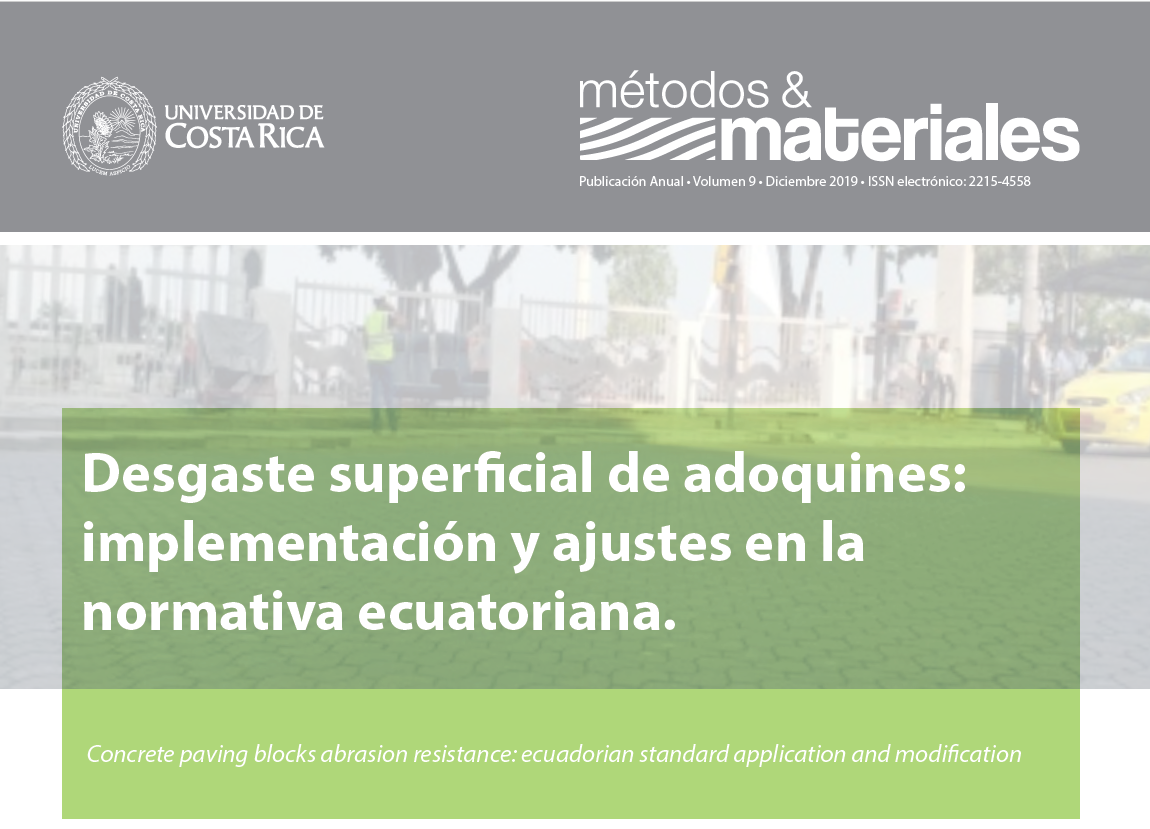Abstract
The quality control of concrete paving blocks in Ecuador has remained unchanged since 1987, using as a criterion of quality and durability the value of the compressive strength of the block under the concept of global indicator. This indicator assumes that when the axial load carrying capacity specification is met, it will cover requirements such as abrasion resistance, therefore the expectations of the paving surface design life. However, in recent years an early deterioration of the paving brick surfaces has been verified in general despite compliance with the axial load carrying capacity requirements established in the Ecuadorian standard. Under these conditions, the University, the construction industry and the Ecuadorian Standardization Institute (INEN) decided to adapt a new control standard in which the indicator of acceptance is broken down into several physical and mechanical parameters, using the European standard EN 1338 as a reference document. Among the parameters, the quantification and assessment of abrasion resistance became of greater interest, both because of the lack of abrasion resistance of most of the production in the country, as well as the test method to be used. The present article, based on a traditional statistical analysis of 516 abrasion resistance tests by means of the wide wheel abrasion test method (EN 1338) performed at the Construction Materials laboratory of the Pontifical Catholic University of Ecuador (PUCE) between 2010 and 2015, verified the symmetrical normal distribution behavior of the two lots in which the data were classified; one corresponding to plants that maintain quality control processes and another to plants without control in addition, quantified the characteristic tyre track value according to the abrasion test in the analysis period. Through the information obtained, the need for abrasion control has been justified, as well as the recommendation to establish a specification for Ecuador, different from that established in the European standard
References
Artega , M., & Valdez, D. (2005). Desgaste de Adoquines de Hormigón. Quito: Pontificia Universidad Católica del Ecuador. Tesis de grado.
Bullen, F. (1992). The Variation in Durability of Concrete Segment Paving Units. Proc. 4th International Conference on Concrete Block Paving, 219-228.
Caiza, M., & Chipugsi, R. (2018). Influencia de las partículas de caucho en el desgaste de adoquines de hormigón. Quito: Universidad Politécnica Salesiana. Tesis de grado.
Chaluiza, A. (2012). Relaciónes de Compresión y tensión en adoquines fabriados con materiales procedentes de la Canatera de Pesillo, ubicado en el cantón Cayambe Provincia de Pichincha. Quito, Pichincha, Ecuador: Universidad Central del Ecuador Tesis de Grado.
Dowson, A. (1996). The Development of the Abrasion Test for Concrete Paving. Proc.5th International Conference on Concrete Block Pavement, 571-578.
European Standard EN 1338. (2006). EN 1338 Concrete Paving blocks-Requirements and test Methods. 1-20.
Ghafoori, N., & Sukandar, M. (1995). Abrasion Resistence of Concrete Block Pavers. ACI Material Journal, Vol 92, 25-36.
Hidalgo, D., & Poveda , R. (2013). Obtención de adoquines fabricados con vidrio reciclado como agregado. Quito: Escuela Politécnia Nacional. Tesis de Grado.
Humpola, B. (1996). Some Aspect of CBP Quality. The Fifthy Internatonal Conference on Concrete Block Paving, 103-113.
Humpola, B., Bullen, F., & Knapton, J. (1996). Quick Quality Control of Concrete Block Pavers in Australia. The Fifthy International Conference on Concrete Block Paving, 55-64.
INEN. (1987). NTE 1485 Adoquines. Determinación de la Resistencia a la Compresión. 1-5.
INEN. (1987). NTE 1488. Adoquines. Requisitos. NTE INEN 1488, 1-4.
INEN. (2011). NTE 2380 Cemento Hidráulico.Requisitos de desempeño para cementos hidráulicos. Quito, Ecuador.
INEN. (2011). NTE 490 Cementos Hidráulicos Compuestors. Requisitos. Quito, Ecuador.
INEN. (2012). NTE 152 Cemento Portland. Requisitos. 1-6.
Jamshidi, A., Kurumisawa, K., White, G., Tatsuo, N., Toshifumi, I., Toyoharu, N., & Jize, M. (2019). State of the art of interlocking Concrte Block Pavement technology in Japan as a post modern Pavement. Constructuion and Building Materials, 715-750.
Metha, K. P., & Monteiro, P. J. (2014). Concrete Microstructure, Properties, and Materials. New York: Mc Grow Hill Education.
Murakami, K., Suda, S., & Ezumi, N. (1998). Study of Wear Resistant Pavement on High Strength Concrete Paviment Block. 2th International Workshop on Concrete Block Paving Cartagena de Indias Colombia, 261-263.
Ortega , L., & Realpe, G. (1992). Uso del cemento Portland IE en la fabricación de adoquines. Quito: Pontificia Universidad Católica del Ecuador. Tesis de grado.
Petit, G. (2003). Abrasion Test Methods for Paving Units. Proc.7th International Conference on Concrete Block Pavement, 1-11.
Shackel, B., & Xiaoping, S. (1992). The abrasioni testing of concrete pavers. Proc.4th international conference on Concrete block pavement, 229-238.
Wuaguang, L., Dongkyu, K., SungWoo, R., Han, H., Ying-En, G., & Yoon Ho, C. (2018). Evaluation of Load Dissipation Behavior of Concrete Block Pavements with Various Block Shapes and Construction Patterns. ASCE Journal of Materials in Civil Engineering, DOI: 10.1061/(ASCE)MT.1943-5533.0002113


